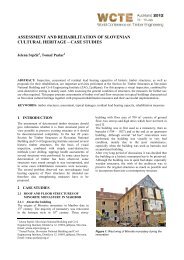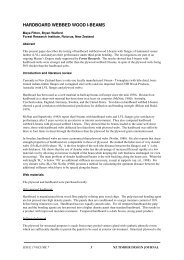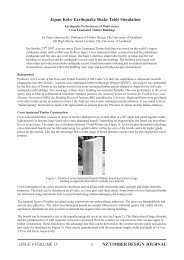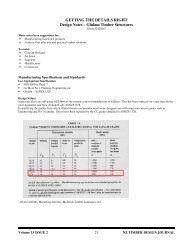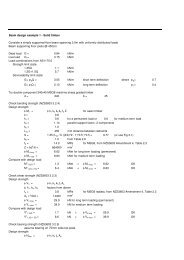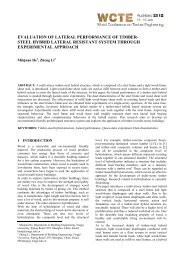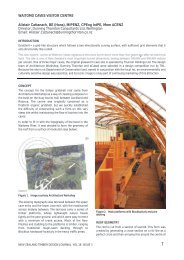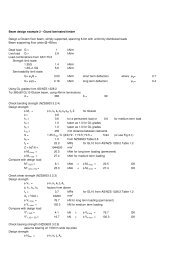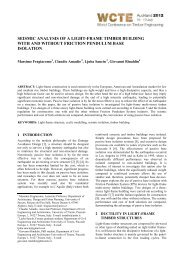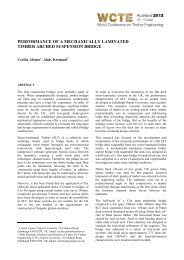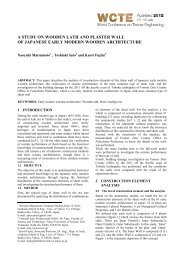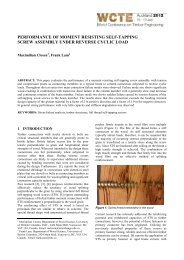Purbond Glue Technologies - Timber Design Society
Purbond Glue Technologies - Timber Design Society
Purbond Glue Technologies - Timber Design Society
Create successful ePaper yourself
Turn your PDF publications into a flip-book with our unique Google optimized e-Paper software.
Title of presentation<br />
New Zealand <strong>Timber</strong> <strong>Design</strong> <strong>Society</strong> - October 2009<br />
Innovation with <strong>Timber</strong> - Adhesives used in Engineered Wood Elements<br />
Walter Stampfli<br />
General Manager <strong>Purbond</strong>
Content<br />
Three parts<br />
• Engineered wood products<br />
• Adhesives for Engineered Wood<br />
• Tendency with gluing of wooden<br />
construction
Engineered Wood Products<br />
• Milestones in Europe in engineered wood<br />
products<br />
• Engineered wood elements in Europe<br />
• Engineered wood products market and trends<br />
• Wood elements have to fulfil modern<br />
requirements
Milestones in Europe in engineered<br />
wood products<br />
1575 - 1770<br />
1906<br />
1930<br />
1940<br />
1990<br />
2000<br />
Baroque<br />
Patent Otto Hetzer<br />
DIN 1052 Germany - First standard for<br />
engineered wood products<br />
Development of finger jointing<br />
KVH – Finger jointed solid timber<br />
Cross laminated timber
Milestones in Europe in engineered<br />
wood products<br />
1575 – 1770 Baroque<br />
Curved, swept and blocked beam construction
Milestones in Europe in engineered<br />
wood products<br />
1906 – Patent Otto Hetzer<br />
Curved, glued laminated timber beams<br />
Beginning of modern engineered wood
Milestones in Europe in engineered<br />
wood products<br />
1930 – DIN 1052 – Germany<br />
First standard for engineered wood products
Milestones in Europe in engineered<br />
wood products<br />
1940 – Development of finger jointing<br />
Better use of the wood: cut out knots and defects and bond<br />
back together
Milestones in Europe in engineered<br />
wood products<br />
1990 – KVH: finger jointed solid timber
Milestones in Europe in engineered<br />
wood products<br />
2000 – Cross laminated timber<br />
Cross-laminated<br />
timber (KLH):<br />
layers of boards<br />
bonded crosswise<br />
to form<br />
large timber<br />
panels
Engineered wood elements - Europe<br />
Glulam<br />
Duo-Trio<br />
beam<br />
Cross beam<br />
Log beam<br />
Finger jointed<br />
studs<br />
KVH
Engineered wood elements - Europe<br />
I-beam<br />
I-joist<br />
Cross<br />
laminated<br />
timber panels<br />
Box girder<br />
solid timber<br />
panels<br />
LVL
Engineered wood products are used in<br />
• Detached houses (single family)<br />
• Apartment houses Multi story wood<br />
construction houses are more and more<br />
accepted in the standards<br />
• Commercial buildings<br />
• Sport/event halls<br />
• Bridges
Housing industry trends in Europe<br />
Multi stories houses
Housing industry trends in Europe
Housing industry trends in Europe<br />
Why are wooden houses in trend?<br />
• Innovative products and construction<br />
• Wood as a material creates a positive effect in<br />
people‘s minds<br />
• Ecological position of wood is accepted
Engineered wood products have to<br />
fulfil modern requirements<br />
„Old“ requirements:<br />
• E1 (Europe)<br />
• F**** (Japan)<br />
• IARC-classification (World Health Organization)<br />
„New“ requirements:<br />
• CARB (California)<br />
• IOS-MAT-0003 (IKEA)<br />
• EPF-S (Europe)
Engineered wood products have to<br />
fulfil modern requirements<br />
CARB (California Air Resources Board)<br />
• Establishes new formaldehyde emission limits for<br />
composite wood products; particleboard (PB),<br />
medium density fiberboard (MDF) and hardwood<br />
plywood (HWPW) panels.
Engineered wood products have to<br />
fulfil modern requirements<br />
CARB<br />
• Applies to products sold, supplied, used, or<br />
manufactured for sale in California<br />
• Requires finished goods to be made from<br />
compliant PB, MDF and HWPW panels<br />
• Establishes enforcement program<br />
• Includes sell-through provisions
Engineered wood products have to<br />
fulfil modern requirements<br />
• ATCM (Airborne Toxic Control Measure) allows<br />
exemption for manufacturers using no-added<br />
formaldehyde (NAF) or ultra low emitting<br />
formaldehyde (ULEF) resin systems<br />
• Requires application<br />
• Approvals case by case<br />
– CARB Executive Order; 2-year approval<br />
• 14 CARB approved (12 NAF; 2 ULEF)<br />
• Recordkeeping requirements
Engineered wood products have to<br />
fulfil modern requirements
Engineered wood products have to<br />
fulfil modern requirements
Engineered wood products have to<br />
fulfil modern requirements
Engineered wood products have to<br />
fulfil modern requirements<br />
EPF-S (Europe)<br />
New proposed standard of the “European Panel<br />
Federation”<br />
• <strong>Design</strong>ed to close the formaldehyde discussion by offering<br />
a very low emitting board to the user at affordable cost<br />
• Based on uniform factory production control rules and<br />
frequent external supervision checks in accordance with<br />
European standards as well as long-standing European<br />
and national regulations<br />
• Boards achieve the formaldehyde expectations of IKEA<br />
and CARB II
Engineered wood products have to<br />
fulfil modern requirements<br />
• Higher comfort<br />
• Better maintenance of value<br />
• Clear energy cost savings<br />
www.minergie.ch
Engineered wood products have to<br />
fulfil modern requirements<br />
Renewable Energy<br />
recommended required<br />
Heat Energy Demand<br />
90 % value limit 60 % value limit<br />
SIA 380/1:2009 SIA 380/1: 2009<br />
Air Density<br />
good proved<br />
Thermal Insulation<br />
20 cm to 25 cm 20 cm to 35 cm<br />
Thermal Protection Glazing<br />
2-fold 3-fold<br />
Thermal Distribution<br />
usual distribution air heating possible<br />
A-Household Appliances<br />
recommended required<br />
Controlled Air Ventilation<br />
required required<br />
Heat Performance Demand<br />
no requirements max. 10 W/m 2 *<br />
* with air heating<br />
Energy Weighting Factor
Engineered wood products have to<br />
fulfil modern requirements<br />
Higher life quality<br />
Comfort<br />
Good climate due to highly<br />
insulated, airtight building shell<br />
Adjustable shading systems<br />
guarantee high comfort in the<br />
summer.<br />
Heat-recovery ventilation allows<br />
a high level of user comfort during<br />
the whole year.<br />
Health<br />
Optimized daylight<br />
Lower noise emissions<br />
Lower pollution through construction<br />
material<br />
Low emissions of radiation (Radon)<br />
Light<br />
Noise<br />
Air<br />
climate<br />
Low pollution<br />
Energy-efficiency<br />
For a defined usage the total<br />
energy consumption lies 25 %<br />
and the<br />
use of fossil fuels lies 50 % under<br />
the average standard<br />
Building ecology<br />
Good availability of raw materials<br />
and high number of recyclable<br />
construction material<br />
Material with lower pollution during<br />
construction<br />
Easy recycling of buildings due to<br />
environmental friendly waste or<br />
recyclable material<br />
Raw<br />
materials<br />
Production<br />
Recycling
An example - http://www.neuemonterosahuette.ch
Summary<br />
• Engineered wood products are established as<br />
construction material.<br />
• There are a variety of innovative engineered<br />
wood products developed and proven in<br />
standardization work.<br />
• Wood products can and have to fulfil modern<br />
requirements in the direction of ecological<br />
position.
Adhesives for Engineered Wood<br />
1900<br />
1930<br />
1940<br />
1970<br />
1990<br />
Casein<br />
Urea-Formaldehyde (UF)<br />
(Phenol)-Resorcinol-Formaldehyde (RF/PRF)<br />
Melamine (Urea)-Formaldehyde (MF/MUF)<br />
One-Component Polyurethane (1C PUR) -<br />
PURBOND
PURBOND – Adhesives<br />
Mid 1980’s<br />
1994<br />
1995<br />
after<br />
App 2000<br />
First applications of PURBOND in the glulam<br />
industry in Switzerland.<br />
PURBOND HB 110 got the approval in<br />
accordance to DIN 1052, after approx. 3 years<br />
testing in comparison to PRF adhesives.<br />
Market introduction of PURBOND HB 110 –<br />
made the success of “KVH” solid wood timber<br />
in Germany. - Since 1995 until 2008 approx. 30<br />
miom 3 KVH was produced.<br />
Widely spread the technology into the different<br />
application finger jointing and face gluing.<br />
Starting with cross laminated timber.
Physical Performance<br />
The quality of an adhesive bond can be defined<br />
according to ultimate strength, resistance to<br />
degradation by moisture, resistance to heat and<br />
elastic behavior.<br />
1. Strength<br />
2. Durability<br />
3. Long-term performance<br />
4. Elastic behaviour and resistance to creep<br />
5. Resistance to high temperatures
Schematic Morphology of<br />
Polyurethanes - Strong and Non-Brittle<br />
Hard segments<br />
• Urethane groups<br />
• Urea groups<br />
• physical network<br />
with H-bridges<br />
Soft segments<br />
• Polyether polyole<br />
• chemical network<br />
unstretched<br />
stretched<br />
hard segment soft segment
2009 PURBOND approvals worldwide<br />
PURBOND HB E<br />
US: Approved for SPF;<br />
SYP in progress<br />
CND: in progress<br />
PURBOND HB and<br />
PURBOND HB S<br />
approved<br />
PURBOND HB 514 in progress<br />
PURBOND HB S (planed for 2010)<br />
PURBOND HB S<br />
PURBOND HB S<br />
PURBOND HB approved<br />
PURBOND HB S in progress<br />
PURBOND HB S<br />
approved
Development Finger Jointing<br />
Application with PURBOND<br />
1990: Roller<br />
application<br />
1998: Comb application 2003: KEBA – Contact<br />
free application
Development Finger Jointing<br />
Application with PURBOND<br />
2003: Camera System 2007: PSS – <strong>Purbond</strong> Security System –<br />
Sensor Technology
Development Finger Jointing<br />
Application with PURBOND<br />
2009: PSS Comb
Development Face Gluing Application<br />
with PURBOND<br />
1995 1998: Nozzles 2002: “Giessrohr”
Save and secured applications with<br />
PURBOND
Save and secured applications with<br />
PURBOND
Save and secured applications with<br />
PURBOND
Safe and clean working environment<br />
PURBOND adhesives applications<br />
Safe, clean, no waste<br />
Secure<br />
Controlled/stored
PURBOND adhesives fulfil modern<br />
environmental requirements<br />
PURBOND adhesives fulfil<br />
• F**** (Japan) – no formaldehyde<br />
• 4 VOC (Japan) – no solvent<br />
• CARB (California)<br />
• IOS-MAT-0003 (IKEA)<br />
• EPF-S (Europe)
Engineered wood constructions are<br />
increasing their market share<br />
PURBOND stands for the latest proven<br />
technology and fulfils all modern<br />
requirements that house investors have.
PIRCHER, Italy
GR Sistemi, Italy
PWP, New Zealand<br />
Our pursuit of product excellence has seen us always looking for proven<br />
technologies that give the finished product an environmental or technical advantage.<br />
We were one of the first sites to utilise <strong>Purbond</strong> Polyurethane Adhesives –<br />
Formaldehyde free and fully waterproof (awarded <strong>Purbond</strong> customer achievement<br />
award for 2007).
ITC, Australia<br />
Australian lumber producer capitalizes on <strong>Purbond</strong> Brand name
Tendency with gluing of wooden<br />
construction<br />
• Wood as construction material is increasing and<br />
the image is changing.<br />
“Old” prejudices<br />
• Wood is specially fire endangered<br />
• Wood is cheap<br />
• Wood does not look nice<br />
• Wood is not noise protective<br />
• Wood is short-lived, it rots and moulds
Effective benefits<br />
Wood<br />
• is easy to process<br />
• is qualified for prefabrication<br />
• has high strength with low weight<br />
• is easy to combine with other materials like steel, glass,<br />
etc.<br />
• is natural, aesthetic, cosy<br />
• is air humidity regulating, heat-insulating, diffusible,<br />
antistatic<br />
• The resistance to fire can be calculated<br />
• Wood has high surface temperature<br />
• Wood constructions are energy efficient<br />
• Short construction time because no humidity brought in
Effective benefits<br />
Ecological benefits:<br />
• Renewable<br />
• CO 2 neutral<br />
• Local availability / short transit<br />
Economic benefits:<br />
• Short construction time<br />
• Low weight with good static performance<br />
• Good thermal insulation<br />
• No non-recyclable waste
Wood the ideal construction material
Projects<br />
DOKA Formwork I-beams<br />
I-beams<br />
since 1997
Projects<br />
Chesa Futura, St. Moritz,<br />
Switzerland<br />
Spruce<br />
Finger jointing and Face gluing<br />
PURBOND ® HB 110 and HB 530<br />
Year 2001
Projects<br />
Salt Storage “Saldome”, Switzerland (1)<br />
Spruce<br />
Face gluing<br />
PURBOND ® HB 181<br />
Year 2005
Projects<br />
Palais de l‘equilibre, Swiss Expo 2002,<br />
Neuchâtel, Switzerland<br />
Spruce<br />
Face gluing<br />
PURBOND ® HB 110<br />
Year 2001
Projects<br />
Toskana Thermae, Bad Sulza, Germany<br />
Spruce<br />
Face gluing<br />
PURBOND ® HB 110<br />
Year 2001
Projects<br />
Scottish Parliament Building, Edinburg, Scotland<br />
Oak<br />
Finger jointing<br />
PURBOND ® HB 110<br />
Year 2001
Projects<br />
Indoor swimming hall,<br />
Italy<br />
Spruce<br />
Face gluing<br />
PURBOND ® HB 181<br />
Year 2006
Projects<br />
Casa Montarina – Six Storey building in timber<br />
construction, Lugano, Swizterland<br />
Spruce<br />
Finger jointing and face gluing<br />
PURBOND ® HB 110 & 530<br />
Year 2008
Tendencies in bonding of wood elements<br />
used in load bearing constructions<br />
Combination Wood to concrete and steel<br />
• Wood – Concrete – Composite systems<br />
• Wood - Steel – <strong>Glue</strong>d Connection<br />
<strong>Glue</strong>d-in rods<br />
<strong>Glue</strong>d-in perforated metal plates<br />
Intersection point<br />
Bearing fixation<br />
Main and lateral fixation
Wood – Concrete – Composite systems<br />
Wood<br />
Concrete<br />
Shear connector
Wood - Steel – <strong>Glue</strong>d Connection
Wood - Steel – <strong>Glue</strong>d Connection<br />
Roller coaster<br />
Wheel track<br />
CR42<br />
1
Wood - Steel – <strong>Glue</strong>d Connection
PURBOND – Adhesives<br />
for a better world.<br />
Thank you for<br />
your attention!



